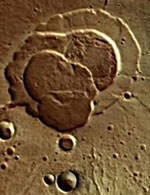
Image credit: ESA
Considered suggestive of life, an atmosphere of methane on another planet is considered one of the four best candidates for detecting habitable conditions using remote sensing and telescope spectrographs. While methane can be made both by biological and non-biological processes, it is also degraded by non-biological means, so a high concentration often is interpreted as requiring a source to replenish it. If metabolism is that source, then some of the prerequisites for a steady-state ecosystem may be in play.
On Earth there are four gases linked to the presence of life and habitable conditions: water vapor, carbon dioxide, methane and molecular oxygen (O2, or its proxy, ozone O3). Water is essential to all biology we understand today, while the exchange of carbon dioxide and oxygen constitute the collective respirator for photosynthesis and breathable worlds. The dominant gas on Mars today is by far carbon dioxide.
With methane, there are some methanogenic organisms that require consumption of this gas for their subsistence. Methanogenesis converts carbon dioxide to methane. Since strong chemical reactions quickly destroy (oxidize) methane at the Martian surface, if methane is found today, there must be some replenishment that gives a clue to active biology. Such biosynthesis leaves a ubiquitous signature of life even in specimens where there are no fossils visible.
Michael J. Mumma of Goddard Space Flight Center first reported in a poster at a recent planetary conference [DPS] that his preliminary search for methane with both of two ground-based infrared telescopes had found something interesting. His survey turned up intriguing signs of what may be methane’s spectral line in the Martian atmosphere.
These hints have now been confirmed by the European orbiter, Mars Express. Using an instrument called the Planetary Fourier Spectrometer (PFS), the work reported in Nature magazine identified the characteristic spectral fingerprint of methane. “We have detected methane at concentrations of ten parts per billion,” said Vittorio Formisano of the Institute of Physics of Interplanetary Space in Rome and the principal investigator in the PFS team.
The current martian atmosphere is 99% thinner than the Earth’s. The surface temperature averages -64 F (-53 C), but varies between 200 below zero during polar nights to 80 F (27 C) at midday peaks near the equator. The global picture of Mars is sometimes compared terrestrially to Antarctic dry regions, only colder.
Carbon, nitrogen and methane would be the gaseous precursors to what would be required to sustain or transform Mars from its current inhospitable state to a warmer, microbe-friendly planet. Because researchers believe that methane can persist in the Martian atmosphere for less than 300 years, any methane they find can be assumed to arise from recent biological processes, produced, for example, by methane-producing bacteria. This close link gives methne its less scientific name of swamp gas.
The European Mars Express mission is capable of detecting methane in the martian atmosphere. As Agustin Chicarro, Mars Express Project Scientist said, these “investigations will provide clues as to why the north of the planet is so smooth and the south so rugged, how the Tharsis and Elysium mounds were lifted up and whether active volcanoes exist on Mars today.”
There are some problems with trying to understand the history of methane and other greenhouse gases on Mars. There is no evidence on Mars of large limestone deposits from the first billion years, which would be directly linked to large amounts of C02, a greenhouse gas.
Methane — which can be created naturally by volcanic eruptions or produced by primitive life — thus may be a missing piece of the puzzle to finding out if organic remnants might once have sustained a primordial Mars. The last period of active volcanism on Mars is well before the last 300 years that methane can survive in the martian atmosphere of today. University of Buffalo volcanologist, Tracy Gregg, told Astrobiology Magazine, “the youngest surficial activity discovered to date (and it’s probably 1 million years old, which would be considered quite young, and possibly “active” on Mars) is in a region that contains no large volcanic structures of any kind.” Mars’ gigantic volcano Mons Olympus was active until 100 million years ago.
Earlier observations had speculated on methane concentrations as high as 50-70 parts per million, not what Mars Express detected as ten parts per billion. This low level could not likely sustain a global pattern suggestive of a biosphere, but might support local ecologies if methane has some underground source. Whatever the final concentration might be, its appearance in such an unstable atmosphere has taken on importance to unravel the mysteries of a martian biosphere. The most frequently mentioned example of a martian methane economy centers on a deep biosphere of methane rich biochemistry, or anerobic methanogens.
Original Source: Astrobiology Magazine
